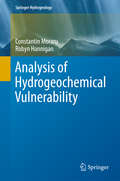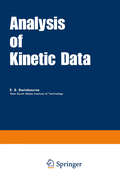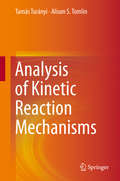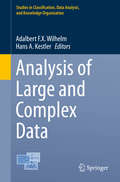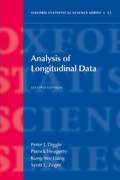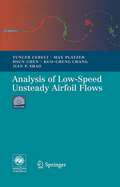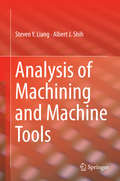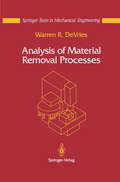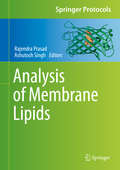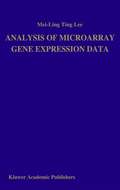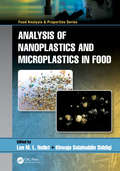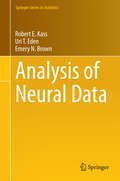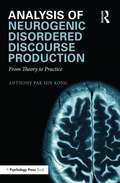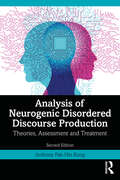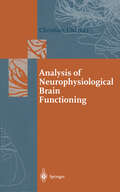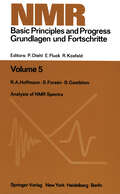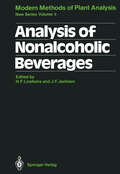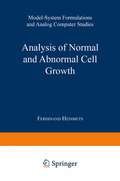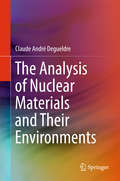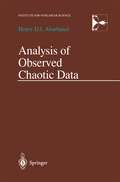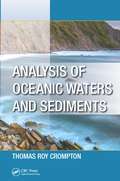- Table View
- List View
Analysis of Hydrogeochemical Vulnerability (Springer Hydrogeology)
by Constantin Moraru Robyn HanniganThis monograph instructs the reader on how to analyze the hydrogeochemical vulnerability. It introduces notions of geochemical signals, points of migration of pollutants in the unsaturated zone, and new hydrogeochemical classifications. Three test sites in the USA, Germany, and Moldova are described as case studies accompanied by illustrative data. The authors presuppose for future readers only the background mathematics and elementary knowledge of hydrogeology. The presented methodology is both for local and regional assessments. It is simple, does not need implication of high qualification specialists and can be applied to test the groundwater quality. The book is useful for undergraduate, graduate, master, and PhD students as well as water quality specialists, ecologists and geology professionals.
Analysis of Kinetic Data (Studies in Modern Chemistry)
by E. S. SwinbourneData analysis is important from two points of view: first, it enables a large mass of information to be reduced to a reasonable compass, and second, it assists in the interpretation of experimental results against some framework of theory. The purpose of this text is to provide a practical introduction to numerical methods of data analysis which have applica tion in the field of experimental chemical kinetics. Recognizing that kinetic data have many features in common with data derived from other sources, I have considered it appropriate to discuss a selection of general methods of data analysis in the early chapters of the text. It is the author's experience that an outline of these methods is not always easy to locate in summary form, and that their usefulness is often not sufficiently appreciated. Inclusion of these methods in the early chapters has been aimed at simplifying discussion in the later chapters which are more particularly concerned with kinetic systems. By the provision of a number of worked examples and problems, it is hoped that the reader will develop a feeling for the range of methods available and for their relative merits. Throughout the text, the mathematical treatment has been kept relatively simple, lengthy proofs being avoided. I have preferred to indicate the 'sense' and usefulness of the various methods rather than to justify them on strict mathematical grounds.
Analysis of Kinetic Reaction Mechanisms
by Tamás Turányi Alison S. TomlinChemical processes in many fields of science and technology, including combustion, atmospheric chemistry, environmental modelling, process engineering, and systems biology, can be described by detailed reaction mechanisms consisting of numerous reaction steps. This book describes methods for the analysis of reaction mechanisms that are applicable in all these fields. Topics addressed include: how sensitivity and uncertainty analyses allow the calculation of the overall uncertainty of simulation results and the identification of the most important input parameters, the ways in which mechanisms can be reduced without losing important kinetic and dynamic detail, and the application of reduced models for more accurate engineering optimizations. This monograph is invaluable for researchers and engineers dealing with detailed reaction mechanisms, but is also useful for graduate students of related courses in chemistry, mechanical engineering, energy and environmental science and biology.
Analysis of Large and Complex Data (Studies in Classification, Data Analysis, and Knowledge Organization #0)
by Adalbert F.X. Wilhelm Hans A. KestlerThis book offers a snapshot of the state-of-the-art in classification at the interface between statistics, computer science and application fields. The contributions span a broad spectrum, from theoretical developments to practical applications; they all share a strong computational component. The topics addressed are from the following fields: Statistics and Data Analysis; Machine Learning and Knowledge Discovery; Data Analysis in Marketing; Data Analysis in Finance and Economics; Data Analysis in Medicine and the Life Sciences; Data Analysis in the Social, Behavioural, and Health Care Sciences; Data Analysis in Interdisciplinary Domains; Classification and Subject Indexing in Library and Information Science. The book presents selected papers from the Second European Conference on Data Analysis, held at Jacobs University Bremen in July 2014. This conference unites diverse researchers in the pursuit of a common topic, creating truly unique synergies in the process.
Analysis of Longitudinal Data (Oxford Statistical Science Ser. #25)
by Peter J. DiggleThe first edition of Analysis for Longitudinal Data has become a classic. Describing the statistical models and methods for the analysis of longitudinal data, it covers both the underlying statistical theory of each method, and its application to a range of examples from the agricultural and biomedical sciences. The main topics discussed are design issues, exploratory methods of analysis, linear models for continuous data, general linear models for discrete data, and models and methods for handling data and missing values. Under each heading, worked examples are presented in parallel with the methodological development, and sufficient detail is given to enable the reader to reproduce the author's results using the data-sets as an appendix. This second edition, published for the first time in paperback, provides a thorough and expanded revision of this important text. It includes two new chapters; the first discusses fully parametric models for discrete repeated measures data, and the second explores statistical models for time-dependent predictors.
Analysis of Low-Speed Unsteady Airfoil Flows
by Tuncer Cebeci Max Platzer Hsun Chen Kuo-cheng Chang Jian P. ShaoThe standard textbooks on aerodynamics usually omit any discussion of un steady aerodynamics or, at most, consider it only in a single chapter, based on two justifications. The first is that unsteady aerodynamics should be regarded as a specialized subject required "only" in connection with understanding and an alyzing aeroelastic phenomena such as flutter and gust response, and therefore should be dealt with in related specialist books. The second reason appears to be reluctance to discuss aerodynamics with the inclusion of the time-dependent terms in the conservation equations and the boundary conditions for fear that added complications may discourage the reader. We take the opposite view in this book and argue that a full understanding of the physics of lift generation is possible only by considering the unsteady aerody namics of the starting vortex generation process. Furthermore, certain "steady" flows are inherently unsteady in the presence of flow separation, as for example the unsteady flow caused by the Karman vortex shedding downstream of a cylin der and "static" airfoil stall which is an inherently unsteady flow phenomenon. Therefore, it stands to reason that a unified treatment of aerodynamics that yields steady-state aerodynamics as a special case offers advantages. This rea soning is strengthened by the developments in computational fluid dynamics over the past forty years, which showed that accurate steady-state solutions can be obtained efficiently by solving the unsteady flow equations.
Analysis of Machining and Machine Tools
by Steven Liang Albert J. ShihThis book provides readers with the fundamental, analytical, and quantitative knowledge of machining process planning and optimization based on advanced and practical understanding of machinery, mechanics, accuracy, dynamics, monitoring techniques, and control strategies that they need to understanding machining and machine tools. It is written for first-year graduate students in mechanical engineering, and is also appropriate for use as a reference book by practicing engineers. It covers topics such as single and multiple point cutting processes; grinding processes; machine tool components, accuracy, and metrology; shear stress in cutting, cutting temperature and thermal analysis, and machine tool chatter. The second section of the book is devoted to “Non-Traditional Machining,” where readers can find chapters on electrical discharge machining, electrochemical machining, laser and electron beam machining, and biomedical machining. Examples of realistic problems that engineers are likely to face in the field are included, along with solutions and explanations that foster a didactic learning experience.
Analysis of Material Removal Processes (Mechanical Engineering Series)
by Warren R. DeVriesMetal removal processes - cutting and grinding in this book - are an integral part of a large number of manufacturing systems, either as the primary manufacturing process, or as an important part of preparing the tooling for other manufacturing processes. In recent years, industry and educational institutions have concentrated on the metal removal system, perhaps at the expense of the process. This book concentrates on metal removal processes, particularly on the modeling aspects that can either give a direct answer or suggest the general requirements as to how to control, improve or change a metal removal process. This modeling knowledge is more important with automated computer controlled systems than it has ever been before, because quantitative knowledge is needed to design and operate these systems. This senior undergraduate/graduate textbook is aimed at providing the quantitative knowledge, often times at an elementary level, for handling the technological aspects of setting up and operating a metal removal process and interpreting the experience of planning, operating and improving a metal removal process based on rule of thumb approaches.
Analysis of Membrane Lipids (Springer Protocols Handbooks)
by Rajendra Prasad Ashutosh SinghThis book provides a timely overview of analytical tools and methodological approaches for studying membrane lipids. It outlines the ground-breaking advances that have been made over the last two decades in high-throughput lipidomics, and in studying lipid-protein interactions, signalling pathways and the regulation of lipid metabolism.This user-friendly laboratory handbook is an ideal companion for membrane biologists, researchers, students, and clinicians alike. It is also well suited for teaching biochemistry, microbiology and biotechnology courses, making it a must-have for everyone whose work involves lipid research.
Analysis of Microarray Gene Expression Data (Trends In Logic Ser.)
by Mei-Ling Ting LeeAfter genomic sequencing, microarray technology has emerged as a widely used platform for genomic studies in the life sciences. Microarray technology provides a systematic way to survey DNA and RNA variation. With the abundance of data produced from microarray studies, however, the ultimate impact of the studies on biology will depend heavily on data mining and statistical analysis. The contribution of this book is to provide readers with an integrated presentation of various topics on analyzing microarray data.
Analysis of Nanoplastics and Microplastics in Food (Food Analysis & Properties)
by Leo M. L. Nollet and Khwaja Salahuddin SiddiqiThe world’s ever increasing use of plastics has created large areas of floating plastic waste in the oceans—so-called plastic soup. This floating plastic debris is gradually fragmenting into smaller particles which eventually become microplastics, and even nanoplastics. Analysis of Nanoplastics and Microplastics in Food compiles data on nanoplastics and microplastics in food. To date, there is some data on this, particularly for the marine environment. Fish show high concentrations, but because microplastics are mostly present in the stomach and intestines, they are usually removed and consumers are not exposed. But in crustaceans and bivalve molluscs like oysters and mussels, the digestive tract is consumed, so there is some exposure. Microplastics have also been reported in honey, beer, and table salt. Key Features: Discusses sampling and analysis of nano- and microplastics Details the impacts of plastic residues in diverse compartments of the environment Includes a discussion of microplastics in freshwater Discusses interactions of microplastics and POPs This book brings to light the reality—and dangers—of microplastics in food. Pollutants like polychlorinated biphenyls (PCBs) and polycyclic aromatic hydrocarbons (PAHs) can accumulate in microplastics. Some studies suggest that, after consuming microplastics in food, these substances may transfer into tissues. So, it is important to estimate the average intake. Since engineered nanoparticles (from different types of nanomaterials) can enter human cells, this reality can pose consequences for human health. Also available in the Food Analysis and Properties Series: Mass Spectrometry Imaging in Food Analysis, edited by Leo M. L. Nollet (ISBN: 978-1-138-37069-2) Proteomics for Food Authentication, edited by Leo M. L. Nollet and Semih Ӧtleş (ISBN: 978-0-367-20505-8) Food Aroma Evolution: During Food Processing, Cooking, and Aging, edited by Matteo Bordiga and Leo M. L. Nollet (ISBN: 978-1-138-33824-1) For a complete list of books in this series, please visit our website at: www.crcpress.com/Food-Analysis--Properties/book-series/CRCFOODANPRO
Analysis of Nanoplastics and Microplastics in Food (Food Analysis & Properties)
by Leo M. L. Nollet Khwaja Salahuddin SiddiqiThe world’s ever increasing use of plastics has created large areas of floating plastic waste in the oceans—so-called plastic soup. This floating plastic debris is gradually fragmenting into smaller particles which eventually become microplastics, and even nanoplastics. Analysis of Nanoplastics and Microplastics in Food compiles data on nanoplastics and microplastics in food. To date, there is some data on this, particularly for the marine environment. Fish show high concentrations, but because microplastics are mostly present in the stomach and intestines, they are usually removed and consumers are not exposed. But in crustaceans and bivalve molluscs like oysters and mussels, the digestive tract is consumed, so there is some exposure. Microplastics have also been reported in honey, beer, and table salt. Key Features: Discusses sampling and analysis of nano- and microplastics Details the impacts of plastic residues in diverse compartments of the environment Includes a discussion of microplastics in freshwater Discusses interactions of microplastics and POPs This book brings to light the reality—and dangers—of microplastics in food. Pollutants like polychlorinated biphenyls (PCBs) and polycyclic aromatic hydrocarbons (PAHs) can accumulate in microplastics. Some studies suggest that, after consuming microplastics in food, these substances may transfer into tissues. So, it is important to estimate the average intake. Since engineered nanoparticles (from different types of nanomaterials) can enter human cells, this reality can pose consequences for human health. Also available in the Food Analysis and Properties Series: Mass Spectrometry Imaging in Food Analysis, edited by Leo M. L. Nollet (ISBN: 978-1-138-37069-2) Proteomics for Food Authentication, edited by Leo M. L. Nollet and Semih Ӧtleş (ISBN: 978-0-367-20505-8) Food Aroma Evolution: During Food Processing, Cooking, and Aging, edited by Matteo Bordiga and Leo M. L. Nollet (ISBN: 978-1-138-33824-1) For a complete list of books in this series, please visit our website at: www.crcpress.com/Food-Analysis--Properties/book-series/CRCFOODANPRO
Analysis of Neural Data (Springer Series in Statistics)
by Robert E. Kass Uri T. Eden Emery N. BrownContinual improvements in data collection and processing have had a huge impact on brain research, producing data sets that are often large and complicated. By emphasizing a few fundamental principles, and a handful of ubiquitous techniques, Analysis of Neural Data provides a unified treatment of analytical methods that have become essential for contemporary researchers. Throughout the book ideas are illustrated with more than 100 examples drawn from the literature, ranging from electrophysiology, to neuroimaging, to behavior. By demonstrating the commonality among various statistical approaches the authors provide the crucial tools for gaining knowledge from diverse types of data. Aimed at experimentalists with only high-school level mathematics, as well as computationally-oriented neuroscientists who have limited familiarity with statistics, Analysis of Neural Data serves as both a self-contained introduction and a reference work.
Analysis of Neurogenic Disordered Discourse Production: From Theory to Practice
by Anthony Pak KongAnalysis of Neurogenic Disordered Discourse Production provides a comprehensive review and discussion of aphasia and its related disorders, their corresponding clinical discourse symptoms that speech-language pathologists and related healthcare professionals should address, and the different methods of discourse elicitation that are research- and clinically-oriented. Contemporary issues related to disordered/clinical discourse production are covered, and discussions of various treatment options in relation to discourse symptoms are included. Finally, the manifestation of discourse symptoms as a function of speakers’ bilingual/multilingual status and specific considerations related to clinical assessment and intervention are explored. Readers who want to learn the background and techniques of discourse analysis, refresh their knowledge of discourse production, update their knowledge of assessment and treatment of discourse production, and learn about contemporary issues of discourse annotation and analysis using existing computer software will find this book a valuable tool. With its comprehensive coverage, it offers a thorough understanding of the nature, assessment, and remediation of discourse deficits in aphasia and related disorders. Readers will also benefit from examples throughout the book that connect theory to real-life contexts of discourse production.
Analysis of Neurogenic Disordered Discourse Production: From Theory to Practice
by Anthony Pak KongAnalysis of Neurogenic Disordered Discourse Production provides a comprehensive review and discussion of aphasia and its related disorders, their corresponding clinical discourse symptoms that speech-language pathologists and related healthcare professionals should address, and the different methods of discourse elicitation that are research- and clinically-oriented. Contemporary issues related to disordered/clinical discourse production are covered, and discussions of various treatment options in relation to discourse symptoms are included. Finally, the manifestation of discourse symptoms as a function of speakers’ bilingual/multilingual status and specific considerations related to clinical assessment and intervention are explored. Readers who want to learn the background and techniques of discourse analysis, refresh their knowledge of discourse production, update their knowledge of assessment and treatment of discourse production, and learn about contemporary issues of discourse annotation and analysis using existing computer software will find this book a valuable tool. With its comprehensive coverage, it offers a thorough understanding of the nature, assessment, and remediation of discourse deficits in aphasia and related disorders. Readers will also benefit from examples throughout the book that connect theory to real-life contexts of discourse production.
Analysis of Neurogenic Disordered Discourse Production: Theories, Assessment and Treatment
by Anthony Pak-Hin KongAnalysis of discourse production among speakers with acquired communication disorders is an important and necessary clinical procedure. This book provides a comprehensive review and discussion of aphasia and its related disorders, their corresponding clinical discourse symptoms that speech-and-language pathologists should address, and the different methods of discourse elicitation that are clinically and research oriented. This edition has been thoroughly updated throughout to include the latest research, including advances in word retrieval and discourse production, cognitive and multicultural aspects of disordered discourse production, application of technology to understand and evaluate spoken discourse, and evidence-based intervention of discourse impairments. Contemporary issues related to disordered/clinical discourse elicitation are added. Recent advancement in discourse analysis is covered and discussions of various treatment options of discourse symptoms are provided. Finally, the manifestation of discourse symptoms as a function of speakers’ multilingual/multi-cultural status and specific considerations related to clinical assessment and remediation are explored. As the only introductory text to include comprehensive coverage of basic knowledge of neurogenic disordered discourse, it is a must-read for students, clinicians, and researchers in various fields. Readers will also benefit from plenty of examples that provide a connection between the theoretical contents presented in the text and application to real-life contexts of discourse production.
Analysis of Neurogenic Disordered Discourse Production: Theories, Assessment and Treatment
by Anthony Pak-Hin KongAnalysis of discourse production among speakers with acquired communication disorders is an important and necessary clinical procedure. This book provides a comprehensive review and discussion of aphasia and its related disorders, their corresponding clinical discourse symptoms that speech-and-language pathologists should address, and the different methods of discourse elicitation that are clinically and research oriented. This edition has been thoroughly updated throughout to include the latest research, including advances in word retrieval and discourse production, cognitive and multicultural aspects of disordered discourse production, application of technology to understand and evaluate spoken discourse, and evidence-based intervention of discourse impairments. Contemporary issues related to disordered/clinical discourse elicitation are added. Recent advancement in discourse analysis is covered and discussions of various treatment options of discourse symptoms are provided. Finally, the manifestation of discourse symptoms as a function of speakers’ multilingual/multi-cultural status and specific considerations related to clinical assessment and remediation are explored. As the only introductory text to include comprehensive coverage of basic knowledge of neurogenic disordered discourse, it is a must-read for students, clinicians, and researchers in various fields. Readers will also benefit from plenty of examples that provide a connection between the theoretical contents presented in the text and application to real-life contexts of discourse production.
Analysis of Neurophysiological Brain Functioning (Springer Series in Synergetics)
by Christian UhlThe analysis of neurophysiological brain function is a highly interdisciplinary field of research. In addition to the traditional areas of psychology and neurobiology, various other scientific disciplines, such as physics, mathematics, computer science, and engineering, are involved. The book reviews a wide spectrum of model-based analyses of neurophysiological brain function. In the first part, physical and physiological models and synergetic concepts are presented. The second part focuses on analysis methods and their applications to EEG/MEG data sets. It reviews methods of source localization, the investigation of synchronization processes, and spatio-temporal modeling based on dynamical systems theory. The book includes contributions by well-known scientists such as Hermann Haken, Scott Kelso and Paul Nunez, among others. It is written for students and scientists from all the above-mentioned fields.
Analysis of NMR Spectra: A Guide for Chemists (NMR Basic Principles and Progress #5)
by R. A. Hoffman S. Forsen B. GestblomNuclear magnetic resonance spectroscopy, which has evolved only within the last 20 years, has become one of the very important tools in chemistry and physics. The literature on its theory and application has grown immensely and a comprehensive and adequate treatment of all branches by one author, or even by several, becomes increasingly difficult. This series is planned to present articles written by experts working in various fields of nuclear magnetic resonance spectroscopy, and will contain review articles as well as progress reports and original work. Its main aim, however, is to fill a gap, existing in literature, by publishing articles written by specialists, which take the reader from the introductory stage to the latest development in the field. The editors are grateful to the authors for the time and effort spent in writing the articles, and for their invaluable cooperation. The Editors Analysis of NMR Spectra A Guide for Chemists R. A. HOFFMAN t S. FORSEN Division of Physical Chemistry, Chemical Center, Lund Institute of Technology, Lund, Sweden B. GESTBLOM Institute of Physics, University of Uppsala, Sweden Contents I. Principles of NMR Spectroscopy 4 1. 1. The Magnetic Resonance Phenomenon 4 a) Nuclear Moments. . . . . . . . 4 b) Magnetic Spin States and Energy Levels 5 c) The Magnetic Resonance Condition. 7 d) The Larmor Precession. . 7 e) Experimental Aspects . . . . 8 1. 2. Chemical Shifts . . . . . . . . 9 a) The Screening Constant 11. . . 9 b) Chemical Shift Scales (11 and r) 10 1. 3. Spin Coupling Constants 12 1. 4. Intensities. . . . . . . .
Analysis of Nonalcoholic Beverages (Molecular Methods of Plant Analysis #8)
by B. Biehl E. Cohen L. W. Doner T. T. Fang P. B. Hutt L. Izquierdo R. L. Johnson P. K. Mahanta I. Saguy P. Schreier K. E. Scott J. M. Sendra T. Shibamoto M. A. Stevens T. Suzuki T. Tsuda P. Vaag L. P. Valenti G. R. Waller G. ZieglederModern Methods of Plant Analysis When the handbook Modern Methods of Plant Analysis was first introduced in 1954 the considerations were: 1. the dependence of scientific progress in biology on the improvement of existing and the introduction of new methods; 2. the difficulty in finding many new analytical methods in specialized journals which are normally not accessible to experimental plant biologists; 3. the fact that in the methods sections of papers the description of methods is frequently so compact, or even sometimes so incomplete that it is difficult to reproduce experiments. These considerations still stand today. The series was highly successful, seven volumes appearing between 1956 and 1964. Since there is still today a demand for the old series, the publisher has decided to resume publication of Modern Methods of Plant Analysis. It is hoped that the New Series will be just as acceptable to those working in plant sciences and related fields as the early volumes undoubtedly were. It is difficult to single out the major reasons for success of any publication, but we believe that the methods published in the first series were up-to-date at the time and presented in a way that made description, as applied to plant material, complete in itself with little need to consult other publications. Contributing authors have attempted to follow these guidelines in this New Series of volumes.
Analysis of Normal and Abnormal Cell Growth (PDF): Model-System Formulations and Analog Computer Studies
by Ferdinand HeinmetsThe Analysis of Nuclear Materials and Their Environments
by Claude André DegueldreThis book provides an overview of passive and interactive analytical techniques for nuclear materials. The book aims to update readers on new techniques available and provide an introduction for those who are new to the topic or are looking to move into actinides and nuclear materials science. The characterization of actinide species and radioactive materials is vital for understanding how these elements and radioactive isotopes are formed and behave and how these materials can be improved. The analysis of the actinides or radioactive materials goes beyond spent fuel science to the applicable complete fuel cycle and including analysis of reactor materials.
Analysis of Observed Chaotic Data (Institute for Nonlinear Science)
by Henry AbarbanelA clear and systematic treatment of time series of data, regular and chaotic, found in nonlinear systems. The text leads readers from measurements of one or more variables through the steps of building models of the source as a dynamical system, classifying the source by its dynamical characteristics, and finally predicting and controlling the dynamical system. It examines methods for separating the signal of physical interest from contamination by unwanted noise, and for investigating the phase space of the chaotic signal and its properties. The emphasis throughout is on the use of modern mathematical tools for investigating chaotic behaviour to uncover properties of physical systems, requiring knowledge of dynamical systems at the advanced undergraduate level and some knowledge of Fourier transforms and other signal processing methods.
Analysis of Oceanic Waters and Sediments
by Thomas Roy CromptonThe presence of concentrations of organic substances and cations in seawater is a matter of increasing concern to the water industry, environmentalists and the general public alike. It poses a threat of possible health hazards for humans, fish and crustacea. Until fairly recently, the analysis of seawater was limited to a number of major constituen
Analysis of Oceanic Waters and Sediments
by Thomas Roy CromptonThe presence of concentrations of organic substances and cations in seawater is a matter of increasing concern to the water industry, environmentalists and the general public alike. It poses a threat of possible health hazards for humans, fish and crustacea. Until fairly recently, the analysis of seawater was limited to a number of major constituen
